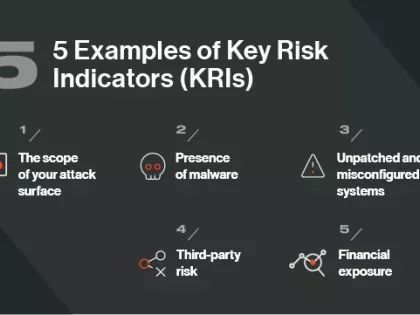5 Strategies for Cyber Risk Reduction Across Your Expanding Digital Ecosystem

Cyberattacks are on the rise and the impact can be devastating. In 2022, the average cost of a data breach increased to $4.35 million. But the fallout can also extend to lost productivity, reputational damage, and regulatory penalties.
While security policies and controls can help defend against these threats, what if you could get one step ahead of them?
Let’s look at five practical strategies that will reduce cyber risk across your expanding digital ecosystem – before it’s exploited by a threat actor.
1. Address Insider Threats
Employees remain the biggest cybersecurity threat any organization faces. After all, they have full access to your systems and data.
In 2021, there was a 72% increase in insider threat incidents. That’s why it’s vital that you ensure multifactor authentication is implemented, access privileges are limited and monitored (55% of organizations identify privileged users as their greatest insider risk) and network behavior is monitored.
It’s equally important to conduct regular cyber awareness training and attack exercises, such as phishing simulations. But for training to be truly effective, you must also foster feelings of responsibility and accountability for cyber risk reduction among employees. After all, a cyber incident can have a big impact on their day-to-day productivity and stress levels. Find out how to promote these feelings in our eBook: The Secret to Creating a Cyber Risk-Aware Organization.
2. Keep Your Systems Up To Date
Software and system updates have a big impact on cybersecurity because they fix previously unknown bugs or vulnerabilities that could be exploited.
Indeed, Bitsight research found a direct correlation between a delay in applying patches and ransomware risk. Organizations with a patching cadence grade of D or F grades were more than 7x more likely to be a victim than organizations with an A grade.
To improve these statistics, use Bitsight to continuously and automatically monitor your digital infrastructure for vulnerabilities and security gaps.
3. Assess and Monitor Vendors
One of the main causes for data breaches is third-party risk. But you may not always know if you're dealing with a high-risk vendor. That’s because traditional methods of assessing and measuring your suppliers’ security postures only provide insight into cyber risk at a point-in-time. They are also expensive, time-consuming, and subjective.
A more effective way to expose risk in your vendor portfolio is by continuously monitoring, revealing, and remediating supply chain risk – from onboarding through the term of the contract.
For instance, with Bitsight for Third-Party Risk Management you can:
- Discover security vulnerabilities in your vendors’ IT infrastructures.
- Receive alerts when a new vulnerability is discovered or a vendor’s security posture dips below pre-agreed risk thresholds.
- Gain insight into your vendors’ historical security performances.
- Share Bitsight’s findings with your vendors for collaborative and rapid remediation.
4. Continuously Monitor Your Attack Surface
As your digital attack surface grows, it's vital that you identify and manage risk hidden across your digital assets. After all, you can’t secure what you can’t see.
Use tools like attack surface analytics to gain visibility into digital assets broken down by cloud provider, geography, and business unit – and the cyber risk associated with each.
Because threats and vulnerabilities are constantly emerging it’s important to continuously monitor your attack surface for new vulnerabilities and risks in addition to maintaining a regular patching cadence. As new threats arise, instant alerts help you prioritize remediation efforts.
5. Run Remediation Scenarios
The ability to recover quickly from a cyberattack is crucial. Your recovery procedure should consider the digital environment – such as the relationship between digital assets, data protection and backup practices, and network segmentation protocols – as well as the possible impacts of an attack. Use attack simulations and recovery exercises to simulate possible scenarios.
Bitsight Forecasting can help. This powerful tool models threat scenarios and potential paths to remediation. It also allows you to see how a change in resource allocation or technology implementation may reduce risk quickly.
Learn more about Cyber Risk Mitigation and Remediation: How to Optimize Both to Better Protect Your Networks – and how Bitsight can help.


